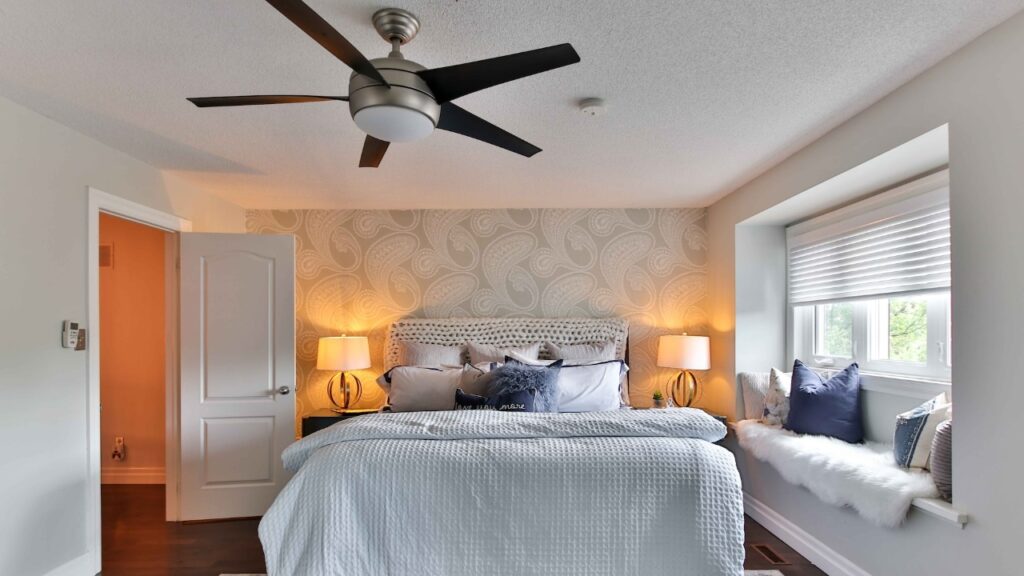Installing a smoke detector in a bedroom ceiling with a fan is an important safety measure to protect you and your loved ones from potential fires. The proper placement of a smoke detector ensures that it can detect smoke and alert you in a timely manner. Here are some guidelines on where to install a smoke detector in a bedroom ceiling with a fan, along with important considerations.
1. Install Near the Center of the Ceiling
- Ideally, the smoke detector should be installed near the center of the ceiling. This location allows for the most effective smoke detection, as smoke rises and spreads evenly across the room. Placing it in the center ensures that it can quickly detect smoke from any direction.
2. Maintain Proper Clearance
- Ensure that the smoke detector has sufficient clearance from any obstructions. This includes ceiling fans, light fixtures, and other objects that could affect its performance. Smoke detectors usually require at least 12 inches of clearance from the nearest wall.
3. Avoid Direct Airflow
- Ceiling fans can create airflow that may affect the performance of a smoke detector. To minimize the impact of the fan’s airflow, install the smoke detector slightly away from the direct path of the fan’s blades. This can prevent the fan from blowing smoke away from the detector.
4. Consider Dual Sensors
- Some smoke detectors come with dual sensors, which include both ionization and photoelectric sensors. These are more effective at detecting different types of fires, such as smoldering fires and fast-flaming fires. Installing a dual-sensor smoke detector in a bedroom with a ceiling fan can enhance your fire detection capabilities.
5. Multiple Detectors for Large Rooms
- If your bedroom is large, it’s a good practice to install more than one smoke detector. Large rooms can have variations in air movement and temperature, which may affect the distribution of smoke. Installing multiple detectors ensures that all areas of the room are adequately covered.
6. Interconnected Detectors
- For enhanced safety, consider using interconnected smoke detectors throughout your home. When one detector detects smoke, it triggers all interconnected detectors to sound the alarm. This is especially important in bedrooms where occupants might be asleep and not hear the alarm from a detector in another part of the house.
7. Follow Manufacturer’s Guidelines
- Always follow the manufacturer’s guidelines and recommendations for the specific smoke detector you’re using. Manufacturers provide instructions on proper installation and maintenance, and these guidelines should take precedence.
8. Battery-Powered or Hardwired Detectors
- Smoke detectors can be either battery-powered or hardwired. Battery-powered detectors are easy to install and can be placed anywhere on the ceiling. Hardwired detectors are connected to your home’s electrical system and are usually installed by an electrician. They are typically interconnected for added safety.
9. Maintenance and Testing
- Once your smoke detector is installed, it’s crucial to perform regular maintenance. Test the smoke detector monthly to ensure it’s functioning correctly. Replace the batteries in battery-powered detectors as needed and replace the entire unit per the manufacturer’s recommendations, usually every 10 years.
10. Follow Local Building Codes
- It’s essential to be aware of and follow local building codes and regulations regarding smoke detector installation. These codes may specify the number and placement of detectors required in a bedroom and throughout your home. Local codes can vary, so check with your local authorities or fire department for guidance.
11. Combination Units
- In addition to smoke detectors, you might consider combination units that include both smoke and carbon monoxide (CO) detectors. Carbon monoxide is a colorless, odorless gas that can be produced by malfunctioning heating systems, stoves, or other appliances. Installing a combination unit in the bedroom can provide protection against both fires and carbon monoxide exposure.
12. Ceiling Height
- Consider the height of your bedroom ceiling when installing a smoke detector. For ceilings that are significantly higher than average, follow manufacturer recommendations regarding proper placement. Some detectors are designed for high ceilings.
13. Ceiling Slopes
- If your bedroom ceiling has slopes or vaulted sections, ensure that the smoke detector is installed on the flat portion of the ceiling, following the manufacturer’s guidelines.
In conclusion, the proper installation of a smoke detector in a bedroom with a ceiling fan is vital for your safety. Follow these guidelines to ensure effective detection of smoke and early warning in the event of a fire. Remember to regularly test and maintain your smoke detectors to keep them in optimal working condition.



Pingback: Ultimate Guide to Bedroom Design - Home Improvement Tips & Ideas